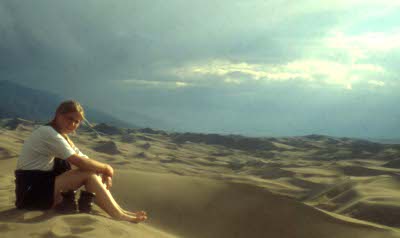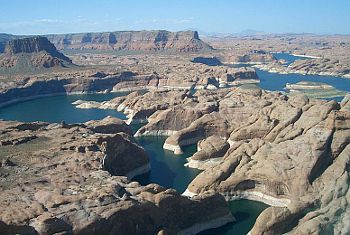The United States has long been reluctant to follow the lead of other developed countries, in recognising the threat of global warming; indeed, while things are slowly changing, there is still a strong lobby of conservative climate-change sceptics in the USA - not least Donald Trump - who argue that global warming is not man-made, so there is no point in bothering about it. But as dramatic climatic excesses cause increasing damage on America's coasts, and inland too, the problems are becoming too big to ignore.

Sand dune desert in Colorado.
In recent years, Americans living in parts of Texas, Arizona and New Mexico have had to get used to an increasing number of summer days with temperatures in excess of 100° Fahrenheit (over 38° Celsius); and last years now long hot dry summers are leading to the destruction by fire of millions of acres of Western forests. Slowly, but perceptibly, the West is already returning to desert; it is a tendency that seems liable to continue.
No one should really be very surprised about this, even without the additional problems due to global warming. Way back in 1878, John Wesley Powell, one of the early explorers of the deserts of the Southwest, warned of the dangers of settling the new lands of the United States to the west of the 100th meridian. Powell submitted a warning to Congress to this effect ten years later, but as often happens, short-term economic interests, not to say vested interests, meant that Powell's warning was not heeded.
In those days, the area now known as the "Great Plains" was more commonly referred to as the Great Desert. From the Rio Grande to the Canadian border, large parts of this region were virtually uninhabited and uninhabitable. Moving sand dunes were a common feature of the landscape, particularly in years of low rainfall. Yet despite the inhospitality of the terrain, from the mid nineteenth century onwards the area was progressively colonized by settlers who made use of any water course possible, to establish farms and homesteads, using irrigation and groundwater to make up for the dryness of the land, or growing plants such as alfalfa which did not require too much rainfall.
Gradually, like a miracle, the taming of the desert began. In the twentieth century, a massive dam building programme was set in motion. In many cases, the dam building was on a gargantuan scale: on the Columbia River alone, as many as 55 dams were built, including the colossal Grand Coulee dam; and although a few early environmentalists pointed to the sheer folly of many of the projects, theirs were literally voices in the wilderness. Many powerful businessmen and speculators, often with friends in Congress, who had much to gain from the dam projects and the generous federal subsidies that often accompanied them, made sure that opposition to their projects was stifled.

Lake Powell, in its desert landscape. Water is low.
Thanks to the dams and the irrigation, agriculture began to flourish in areas where it should never have flourished, and millions of settlers moved into the region, establishing towns and cities that put even more pressure on the area's scarce water resources.
Now serious problems are arising; the level of the region's main underground water table, the Ogallala Aquifer, is falling, and its salinity is increasing; tens of thousands of acres of land have already been taken out of agriculture, and the deserts are once again spreading out.
Today, the remains of the Great American Desert cover an area of some 227,000 km2, mostly in California, Arizona and Nevada; this is the land of cacti and yuccas, "Joshua Trees" creosote bushes, and other drought-resistant plants that can survive in this hot arid region; but the "sage brush desert" stretches much further, and sand dunes and "bad lands" are found as far north as South Dakota.
At the head of a now fertile valley in Colorado, Great Sand Dunes National Monument, the largest area of dunes in the USA, stands as a very visible reminder that it will not take much to bring back the deserts that once covered a large part of the American West. A six degree rise in average temperatures could be more than enough to do just that.
WORDS
alfalfa: lucerne - dam: barrage - drought: dryness - forecast : predict - get used to: become accustomed to - heed: respect - inhospitality: quality of being unsuitable for human habitation - seems liable to : may perhaps - sage brush: a low bush that covers large arid areas of the American west - scarce: rare - sheer: total - stifle: stop - taming: domestication - vested interests: personal interests - wilderness: desert -
Copyright notice.
© Texts and photo linguapress.com. This text may not be reproduced on other websites nor in printed form without written permission from the publishers. Reproduction is authorised exclusively for personal use by students, or for use by teachers with their classes.
WORKSHEET
Deserts
of America
True or false questions
Here are six statements: read the article, and decide which ones are true, and which are false.1.
The western desert was much larger 200 years ago than it is today. (T/F)
2. The main cause of the desertification of the west is global warming. (T/F)
3. “Lake Powell" is named for John Wesley Powell, who first discovered it. (T/F)
4. Grand Coulee dam is one of many dams on the Columbia River. (T/F)
5. Agriculture is not the only big user of water in the American west. (T/F)
6. The Ogallala Aquifer is a large and popular lake. (T/F)
2. The main cause of the desertification of the west is global warming. (T/F)
3. “Lake Powell" is named for John Wesley Powell, who first discovered it. (T/F)
4. Grand Coulee dam is one of many dams on the Columbia River. (T/F)
5. Agriculture is not the only big user of water in the American west. (T/F)
6. The Ogallala Aquifer is a large and popular lake. (T/F)
Careful reading for information
Here is a parallel version of the three first paragraphs of the article. Read it carefully; in most cases, the information, though expressed diffrerently, has the same meaning as the original; but in ten cases, this is not the case, and the second text says something different. Underline all the cases where the information given is not the same as the information presented in the original article.
IF GLOBAL WARMING becomes as serious as some
scientists are now predicting, camels might become the animals most
suited to living in a large part of the American West
by the year 2200 . An average temperature increase of six degrees,
which certain computer models are now
suggesting, might leave much of the USA, from the Mississippi to the
west coast, uninhabited.
These last few years, Americans living in parts of Texas, Arizona and Mexico have had to accustom themselves to increasingly frequent summer days with temperatures over 100° Fahrenheit (nearly 38° Celsius); and and most years now, long hot summers without rain are leading to the destruction by fire of millions of acres of Western forests. Slowly, but invisibly, the West is already reverting to desert; it is a tendency that seems certain to continue.
No one could really be very surprised about this, even without the big problems caused by global warming. As long ago as 1878, John Wesley Powell, one of the first explorers of the Southwestern deserts, warned of the dangers of cultivating the new lands to the west of the 100th meridian. Powell submitted a warning to Congress on this point ten years later, but as often happens, short-term economic considerations, not to say vested interests, meant that Powell’s warning was not read..
These last few years, Americans living in parts of Texas, Arizona and Mexico have had to accustom themselves to increasingly frequent summer days with temperatures over 100° Fahrenheit (nearly 38° Celsius); and and most years now, long hot summers without rain are leading to the destruction by fire of millions of acres of Western forests. Slowly, but invisibly, the West is already reverting to desert; it is a tendency that seems certain to continue.
No one could really be very surprised about this, even without the big problems caused by global warming. As long ago as 1878, John Wesley Powell, one of the first explorers of the Southwestern deserts, warned of the dangers of cultivating the new lands to the west of the 100th meridian. Powell submitted a warning to Congress on this point ten years later, but as often happens, short-term economic considerations, not to say vested interests, meant that Powell’s warning was not read..
For teachers
1. Using the audio text
There are small differences of expression between the audio and the written versions of the text. These are not factual differences, but illustrate different ways of expressing the same thing. Have students pick as many of these out as they can. Alternatively, note them down for yourself, and after students have been through the written and audio versions, ask them to recall, from memory, the synonyms used in the audio text (or the written text)2.
Reading for information : answers:
The following words do not give the same meaning as the words used in the original text.by the year 2200 .
uninhabited.
and Mexico
nearly 38°
Slowly, but invisibly,
seems certain to continue.
No one could really
without the big problems
dangers of cultivating
Powell’s warning was not read..
Role Play activity:
It is the year 2030, and the small town of Stickenburg, Arizona, is in crisis. Local farmers have mostly gone out of business, because irrigation has become so expensive, and many people are desperate. The Mayor has called a citizens’ meeting to discuss the situation. Some people say the only solution is to leave, others are determined to stay.....
© Linguapress.com





 Copyright
information.
Copyright
information.